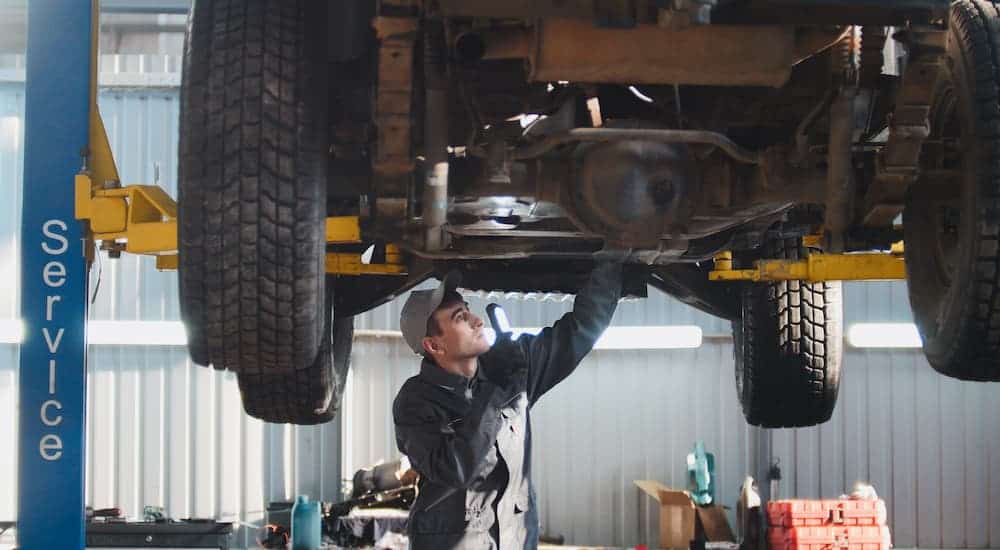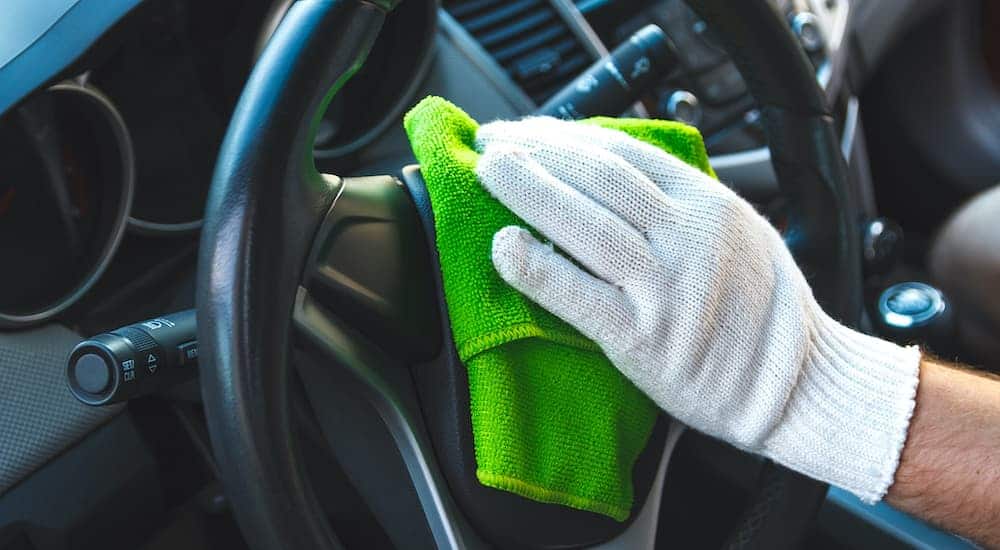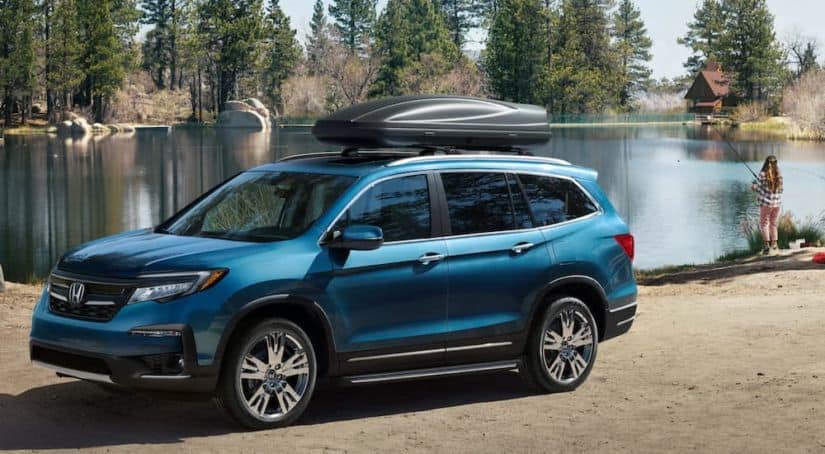Close your eyes and picture your SUV––a used Honda Pilot or a brand new CR-V, perhaps––on the day you brought it home. Inhale that fresh new car smell and take in the crisp, symmetrical vacuum lines on the pristine floor mats. Every inch of your perfect, blemish-free vehicle shined. You were careful that first day, quickly wiping up the moisture gathering in the cupholder from your afternoon iced latte and promising yourself that no one will ever eat in there.
Flash forward to today and tell us, just how many Cheerios are hiding in the seat cracks? How many princess stickers adorn the rear windows? When your toddler spilled the juice in his sippy cup (you know, the cup that wasn’t supposed to leak), did you tell yourself you’d mop it up when you got home but ran out of energy and let it dry up into a ring of crusty yuck instead?
We get it. Raising a family is hard, and since we live in our SUVs, it’s inevitable that they’ll eventually reflect the reality of life with kids. It’s messy, for sure. What if you still long to slide into an immaculately clean car every day but have no idea where to begin? We’ve got your back, and it won’t require an expensive detailing bill. You can keep your used Honda Pilot or another vehicle you drive showroom new with a few tips, some helpful products, and a little bit of elbow grease.
Before we dive in, though, a little reminder: it doesn’t matter how clean your vehicle is if you don’t bring it in for regular service. We’ll cover the ins and outs of scheduled maintenance, including the importance of keeping your oil clean and your tires rotated. If you keep up with your vehicle’s required maintenance, you can focus more on making the inside an oasis of calm and order.
The Importance of Regular Maintenance
The good news is, keeping your SUV well-maintained isn’t hard. In fact, the dealer probably included a recommended maintenance schedule in your paperwork. Can’t put your hands on it? Not to worry. Regular maintenance is somewhat universal, so following a few standard guidelines is all you have to do.
Let’s use the Honda Pilot SUV as an example: newer models, like a 2016 Honda Pilot, for example, require oil changes every 3,000-10,000 miles, depending on the type of oil you use. Conventional motor oil requires more frequent oil changes because it gets dirtier faster, while synthetic oil––the highest quality motor oil––lasts longer. It will cost you more to use synthetic oil, but the benefit is less frequent trips to the dealer for oil changes. On average, you’ll want to change your oil every 5,000 miles.
Most dealers recommend a tire rotation every time you change your oil. Tire rotations allow for more even tire tread wear because as they’re rotated, they make contact with the road differently at each position, so they wear evenly. That means more balanced handling over the long term. Rotating your tires at the same facility is critical because they’ll follow a predetermined pattern that ensures the tires rotate to each of the four spots.
Honda recommends more comprehensive service at each 20,000-mile interval, including inspecting the brakes, fuel lines, the exhaust system, the suspension, and all fluid levels. During these longer service appointments, your dealer will also change the cabin air filter and flush out and clean different fluids––such as rear differential fluid––to keep the engine in top running condition.
The big milestone in any used Honda is when the odometer hits 60,000. The vehicle will need comprehensive service and a multi-point inspection to ensure it’s weathering the higher miles as well as it did when it was newer. The inspection may reveal a need for smaller part replacements due to normal wear-and-tear. It’s not unusual to need new brakes, a new timing belt, or service on the tie rods and steering system.
The important thing with any car is to follow the manufacturer’s guidelines. That way, you’ll have the peace-of-mind of knowing that your SUV stays in the safest, best possible condition.

Deep Cleaning Your SUV
If you’re like most people, you probably run your car through the car wash pretty regularly. Unfortunately, you likely skip the interior cleaning. It doesn’t matter if you’re fastidiously clean or if your SUV regularly resembles the inside of a dumpster––you’ll need to deep clean and detail the inside of your vehicle at least once a month to properly maintain interior surfaces and keep it looking like new.
Step one: empty all the junk out of your car. Remove everything, including trash, empty coffee cups, and children’s toys. Slide the seats forward and search underneath rear bench seats for any wayward items. Empty everything, including the catchall center console. If you’re lucky, you’ll find enough loose coins to buy a coffee.
Before you go crazy with cleaners, thoroughly vacuum the interior. Start at the headliner and work your way down to catch all the dust and dirt, not just the Cheerios dust you can see. We highly recommend a powerful handheld vacuum, like a Black+Decker Dustbuster, to make the job easy and hassle-free. If not, a typical Shop Vac with a long hose will do the job. You may need a special detailing brush––available at auto supply stores––to dig into the vents and other tight spots. Remember, work top-to-bottom to avoid going over the same area twice.
Once your car is vacuumed, scrub the surfaces. Be sure and purchase the right cleaning products for the materials you’re cleaning (we like the big selection offered by Meguiar’s and Armor All). Use only leather cleaners on leather interiors, and stick with a fabric freshener, like Febreeze, to freshen up cloth seats. Got a stain? Try a mix of baking soda and water, and scrub with a toothbrush.
Clean the inside window glass with a glass cleaner and some paper towels. Then, wipe down the dash, steering wheel, consoles, and in and around any pockets or storage cubbies. You may find it necessary to run the vacuum a final time once you’ve finished to pick up extra dust and crumbs. If you prefer green cleaners, try Natureshield’s line of all-purpose cleaners. The company makes organic, biodegradable leather and vinyl protectors, as well as carpet cleaners.

Keeping Your Car Clean and Maintained
As with any other positive change, developing new habits is necessary in order to make it stick. Get in the habit of taking 10 minutes at the end of each day to clean out your car. Remove everything that doesn’t belong, like kid clutter, loose change, and trash. This daily habit will save you time and headaches, and your car will stay clutter-free.
Visit the car wash once a week, or more frequently during the winter months, to keep grime from accumulating and damaging the paint. Bonus points if you take a few extra minutes to vacuum the floor mats. Also, take a minute to toss any accumulated trash every time you fill up your gas tank. Keep a stash of wet wipes and paper towels in your vehicle for handy clean-up of spills and accidents. Taking care of a spill right away reduces the risk for significant damage or stains and keeps your car looking and smelling fresh.
Maintaining your vehicle, both mechanically and cosmetically, pays big dividends in the long run. You’ll keep the interior looking and smelling fresh, so when it comes time to trade or sell your car, you’ll be confident choosing “excellent” when listing the vehicle’s condition. A little elbow grease and some positive habit-setting is all it takes. It’s time to banish the Cheerios dust and win the war against clutter!



